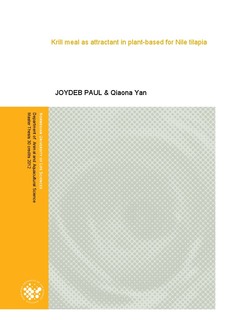Krill meal as attractant in plant-based diets for Nile tilapia
Master thesis
Permanent lenke
http://hdl.handle.net/11250/186157Utgivelsesdato
2013-03-26Metadata
Vis full innførselSamlinger
- Master's theses (IHA) [318]
Sammendrag
Three diets for juvenile Nile tilapia Oreochromis niloticus were prepared substituting
5% of plant protein with products from Antarctic krill (Euphausia superba). Plant
material was used as the sole source of protein in the control (Diet 1). Diets 2 and 3
had plant protein with different levels of krill meal (2.5% KM+2.5%KFC and 5%
KM, Diets 2 and 3 respectively). The diets provided 384 g crude protein kg-1, 275 g
pre-extruded starch kg-1 and 111 g lipid kg-1. The diets were fed approximately 10%
in excess of satiation to triplicate groups of Nile tilapia four times daily for 28 days.
Each diet contained 80 mg Y2O3 kg-1 diet for digestibility determination. Fish of an
initial average weight 25 ± 2g were stocked in nine tanks (70×50×50 cm), with 20
fish per tank, supplied with 27 ± 1o
C water. The final mean weight of the tilapias was
90-104 g (28 days of feeding). Fish fed 5% krill meal supplemented diets had no
significant difference in growth performance (P> 0.05) compared with fish fed plant control diet. While fish fed the 2.5% KM+2.5% KFC supplemented diet had
significantly inferior growth (P < 0.05) compared with control and 5% KM diet. Feed
intake and feed conversion ratio did not differ significantly for fish fed 5% KM diets
compared with the plant control. But fish fed the 2.5% KM+2.5% KFC diet had the
significantly more efficient feed conversion compared to other two diets. Fatty acids
composition was significantly changed in fish body by feeding the different diets and
fish fed by KM significant higher omega-3 fatty acids content in whole body. There
were no significant differences found from chemical compositions of fish body
(except ash content), digestibility of nitrogen and phosphorus, and utilization of the nutrients, such as nitrogen retention, energy retention and phosphorus retention.
